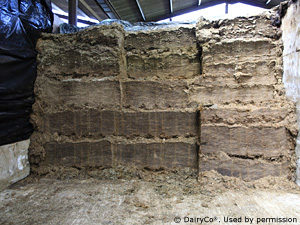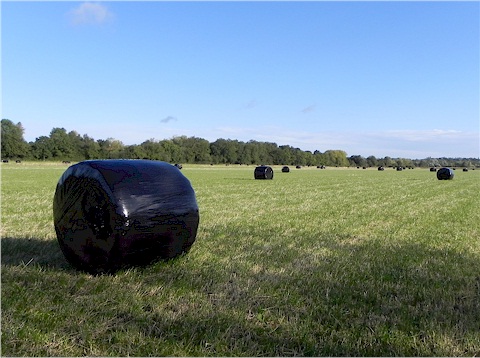Forage Budgeting
31 July 2018With reports of farmers currently having 25-40% less silage than normal and some cattle who are already eating into that supply, to buffer performance, it is extremely unlikely that the higher dry matter forage will fully compensate for the lack of volume.
On the basis that fodder and concentrate feeding is going to be more expensive this winter, preplanning will be even more valuable than usual, says Robert Logan Livestock Business Consultant, SAC Consulting. Whilst energy and protein drive performance, the first major concern is ensuring enough forage dry matter. For that reason, it is best to calculate feeding days available in order to judge what to do next:-
- Calculate the volume of forage available – clamp length (L) x breadth (B) x height (H). Calculate the wedge and sloped sides separately (L x B x H ÷ 2), before adding onto the total cubic meterage (m3).
- Convert volume (m3) into estimated tonnage – assume 600kg/m3 for dry silage, grass (wholecrop and maize silage have similar crop densities). Therefore, if 1,000m3 x 0.6t = 600t forage freshweight. And if there is no effluent it will be +30%DM i.e. 600t x 0.3 = 180t dry matter. Refine this stage once a silage analysis is available. Similarly, weigh a few bales as they can differ significantly.
- Calculate silage demand – the size of animal, body condition, stage of pregnancy, liveweight gain etc all impact actual demand. A formulated ration will be required to better match silage(s) to stock-class. In the meantime, let’s assume this dry matter is required for 100 cows and 86 weaned calves at 9kgDM/d and 4kgDM/d from grass silage (including 10% for wastage) over 180d winter. That is 224t DM demand. A rough table is provided below to support individuals calculations:
Estimated forage dry matter intakes per day
Spring calving beef cows 8 kg DM/d
Autumn calving beef cows 10 kg DM/d
Store cattle 1.5 kg/100kg lwt
Ewe 1.4 kg DM/d
- Is there a shortfall? – continuing the above example, with 224t required and 180t available leaves a 44t DM shortfall, which would be one month less than the budgeted 6-month winter!
- Consider options – (1) do nothing and hope for a kind autumn or early spring to shorten the housing period, but this risks being exposed to (probably) more expensive feed prices in early-spring and/or significantly damaging pasture. (2) sell weaned calves rather than yearlings is an option but is that cost effective for the business? (3) secure more feed now.
- Adjusting for a shortfall – there may still be time to take another cut of silage or wholecrop spring cereals. To calculate requirements reverse stage two above i.e. with a 44t DM shortfall, if budgeting on 30% DM forage = 44 ÷ 0.3 = 147t freshweight. Supposing a yield of 12t FM/acre spring barely wholecrop would require 13 acres.
NB: this is a budget that should be refined once more accurate information becomes available and revisited in the early months of feed-out. It is recommended to analysis the silage as soon as possible and build those figures into ration formulation(s). This process can then be used to budget other feed (and straw-bedding) demands, accounting for forage quality and budgeted livestock performance. Judging by early signals from the feed and livestock markets, continuing this process and reviewing it throughout the autumn will be necessary to support cashflow and performance this winter.
You can download our handy feed budgeting guide here.
Robert Logan
Sign up to the FAS newsletter
Receive updates on news, events and publications from Scotland’s Farm Advisory Service


